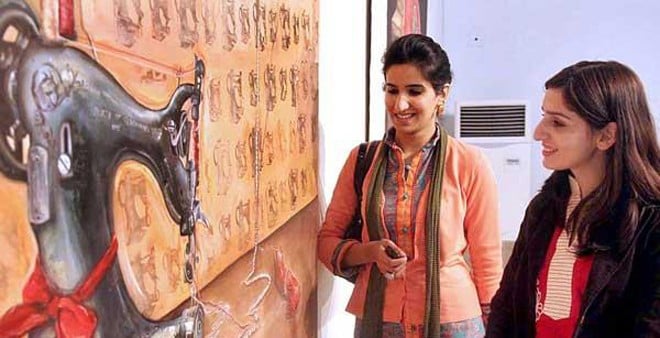

It seemed like a fish market or a summer sale. It certainly did not look like the preview of a degree show at a premier art institution of Pakistan. On the opening day, a horde of people who happened to be potential buyers pushed each other to be the first to choose art pieces. There were arguments and unpleasant exchanges among those trying to grab their chosen work before anyone else could lay his hands on it. The artists, mind you, are not known or famous at the moment but probably will, in the years to come.
This is nothing unusual. One is accustomed to witnessing this hype, of purchasing art on a massive scale in record time, in many degree shows in major urban centres of the country.
In a way, there’s a positive side to it since galleries are always grumbling about the shrinking numbers of buyers or the lack of new and exciting artists appearing on the art scene. However, one needs to analyse this phenomenon in order to comprehend its contradictions.
There are many factors which draw people to graduating students’ work. Freshness of approach, newness in imagery and affordability of prices are a few incentives no doubt. The buyers’ eagerness and excitement is significant for supporting the new art of Pakistan. But one is required to understand the mindset behind the madness. One, with the element of novelty, each buyer is sort of discovering an original talent. At the same time, it satiates the human desire for gambling; the act of buying works of unknown artists on lower prices is a form of blind investment for the future.
Yet, many collectors actually like works by these unrecognised artists for aesthetic reasons as they genuinely appreciate the subject, imagery, technique, material, format or size of an artwork. While making their selections to satisfy their personal taste, they often seek to acquire a pair, without making a distinction between a steel sculpture, a canvas in oil or a miniature painting. This wish to get two works, which must correspond to each other in scale, surface or colour, is the outcome of the desire to decorate a house with beautiful objects. Whenever a connoisseur decides or desires to have a set of artworks, one realises he is treating art like any other pretty product that enhances the grandeur of his residence or office and complements the chromatic scheme of an interior.
The varying motives or intentions of buyers notwithstanding, their swarming number and enthusiasm to obtain artworks are a good sign for an art institution. This testifies the validity of art being taught at that place and its potential as a profession to be adopted and not just as an academic exercise.
This leads to certain complexities too. It brings out a dilemma to the fore -- the tension between art as an intellectual endeavour and a money-generating commodity. For many years, art institutions had been avoiding this reality and, in their puritan approach, neglecting the business of marketing art. Due to this duality, graduating students sold their works like vendors who raise or lower their prices by judging the collector’s potential wealth.
To some degree, this attitude still continues. It is time the institution acknowledges its role in regulating the selling of art from its premises and plans to train its students in market ethics. It must expect a decent attitude from the buyers too who are always keen on getting a discount as if they have not come to at an art exhibition but are picking apricots from a fruit stall.
Perhaps, the greatest benefactors and losers of this sale at degree shows are the graduating students. Often, they are fortunate enough to earn back their entire expenses, along with profit, besides getting invited to exhibit at various venues. At the same time, this experience produces unexpected or negative results; hampering a young artist’s natural growth and making him a complacent professional. The quick success and demand for more works puts pressure on him to recreate similar works. A dilemma that is hard to resolve unless one has strong willpower and a clear vision.
The triumph at degree show generates another response -- the graduating student feels it is difficult to meet the standard set by him or to move beyond that level as expected by others. Over the years we have seen that, after that early exposure, majority of the graduating students fail to grow into practicing artists as they seemed to promise at the time. They can’t come out of that initial bubble.
Today, the contact with market is an unavoidable reality, if not the only truth. This market mania will continue until the new generation of artists take a step ahead and produces works that can not be purchased like installations or video pieces, or works that can be possessed by more than a single individual (such as digital prints). Then, perhaps, the art at degree shows will be enjoyed for its worth as an aesthetic entity rather than for its value as a commercial commodity.